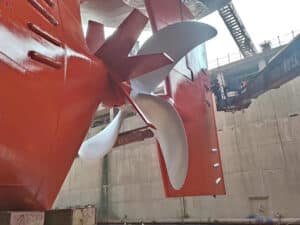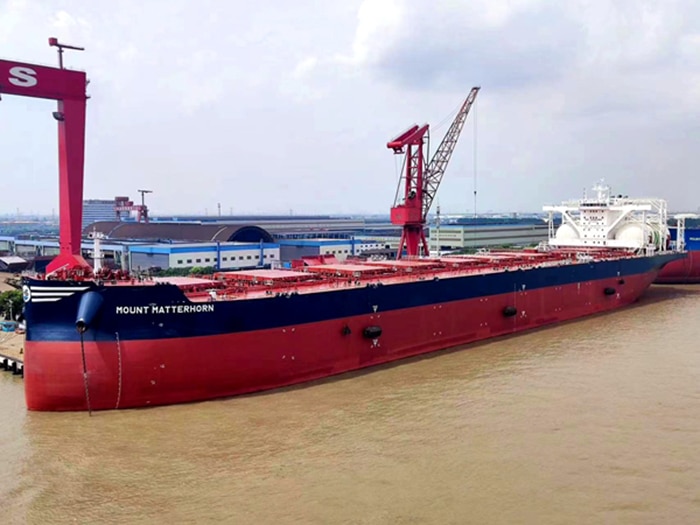
Himalaya Shipping bunkers two bulkers with LNG
Written by Nick Blenkey
Mount Matterhorn is one of two dual fuel Himalaya Shipping bulkers recently bunkered with LNG. [Photograph: New Times Shipbuilding]
Two LNG dual-fueled Newcastlemax bulkers have recently bunkered with LNG in Singapore. Why is that news? It’s often forgotten that just because ships are capable of burning LNG as fuel it doesn’t mean that they are burning it. The price of LNG also has a lot to do with things and recently it’s been high. Nearly all LNG-fueled vessels being dual-fueled, it’s anybody’s guess how many them of them have actually been operating on fuel. Now, in a hopeful sign that things that could be turning around, bulker operator Himalaya Shipping reports that two of its ships, Mount Norefjell and Mount Matterhorn, have bunkered with LNG in Singapore over the last few days.
Mount Matterhorn is the fifth of the twelve 210,000 dwt Newcastlemax dual fuel newbuildings that the company has on order at New Times Shipbuilding in China.
A Newcastlemax running on LNG reduces its CO2 emissions by 43% compared to a standard Capesize ship, in addition to significantly reducing SOx and NOx, says Himalaya Shipping. It reports that, on July 31, 2023, LNG prices (adjusted for calorific values) were $472/tonne compared to $537/tonne for HFO and $610/tonne for VLSFO.
“We are pleased to see the first LNG bunkering of the Himalaya ships,” says CEO Herman Billung. “Both the environmental and economic benefit of running on LNG make us confident in our choice to invest in dual fuel engines. The high LNG prices seen in the wake of the Russia-Ukraine conflict seem to be normalizing, and we believe, over time, LNG prices will trade at a discount to oil. Of the around 2000 Capesize+ dry bulk ships in the world, less than 2% can run on LNG, hence, Himalaya Shipping is well positioned to benefit from the environmental regulations being introduced.”
When Mount Matterhorn was delivered, on July 14, slightly ahead of schedule, Himalaya Shipping said that it would commence a 32-to-38-month time charter plus an option for 11 to 13 months and will earn an index-linked rate, reflecting a significant premium to a standard Capesize vessel. The time charter also includes a profit sharing of any economic benefit derived from operating the vessel´s scrubber or running on LNG, as well as certain rights to convert the time charter to fixed rate based on the prevailing forward freight agreement (FFA) curve from time to time.




